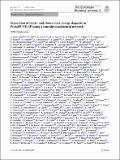| dc.contributor.author | Abed Abud, A. | |
| dc.contributor.author | Abi, B. | |
| dc.contributor.author | Acciarri, R. | |
| dc.contributor.author | Acero, M. A. | |
| dc.contributor.author | Adames, M. R. | |
| dc.contributor.author | Adamov, G. | |
| dc.contributor.author | Adamowski, M. | |
| dc.contributor.author | Adams, D. | |
| dc.contributor.author | Adinolfi, M. | |
| dc.contributor.author | Aduszkiewicz, A. | |
| dc.contributor.author | Aguilar, J. | |
| dc.contributor.author | Ahmad, Z. | |
| dc.contributor.author | Ahmed, J. | |
| dc.contributor.author | Aimard, B. | |
| dc.contributor.author | Ali-Mohammadzadeh, B. | |
| dc.contributor.author | Alion, T. | |
| dc.contributor.author | Allison, K. | |
| dc.contributor.author | Alonso Monsalve, S. | |
| dc.contributor.author | AlRashed, M. | |
| dc.contributor.author | Alt, C. | |
| dc.date.accessioned | 2022-10-17T12:25:56Z | |
| dc.date.available | 2022-10-17T12:25:56Z | |
| dc.date.issued | 2022-10-12 | |
| dc.identifier.uri | https://hdl.handle.net/1721.1/145851 | |
| dc.description.abstract | Abstract
Liquid argon time projection chamber detector technology provides high spatial and calorimetric resolutions on the charged particles traversing liquid argon. As a result, the technology has been used in a number of recent neutrino experiments, and is the technology of choice for the Deep Underground Neutrino Experiment (DUNE). In order to perform high precision measurements of neutrinos in the detector, final state particles need to be effectively identified, and their energy accurately reconstructed. This article proposes an algorithm based on a convolutional neural network to perform the classification of energy deposits and reconstructed particles as track-like or arising from electromagnetic cascades. Results from testing the algorithm on experimental data from ProtoDUNE-SP, a prototype of the DUNE far detector, are presented. The network identifies track- and shower-like particles, as well as Michel electrons, with high efficiency. The performance of the algorithm is consistent between experimental data and simulation. | en_US |
| dc.publisher | Springer Berlin Heidelberg | en_US |
| dc.relation.isversionof | https://doi.org/10.1140/epjc/s10052-022-10791-2 | en_US |
| dc.rights | Creative Commons Attribution | en_US |
| dc.rights.uri | https://creativecommons.org/licenses/by/4.0/ | en_US |
| dc.source | Springer Berlin Heidelberg | en_US |
| dc.title | Separation of track- and shower-like energy deposits in ProtoDUNE-SP using a convolutional neural network | en_US |
| dc.type | Article | en_US |
| dc.identifier.citation | The European Physical Journal C. 2022 Oct 12;82(10):903 | en_US |
| dc.contributor.department | Massachusetts Institute of Technology. Laboratory for Nuclear Science | |
| dc.contributor.department | Massachusetts Institute of Technology. Department of Physics | |
| dc.identifier.mitlicense | PUBLISHER_CC | |
| dc.eprint.version | Final published version | en_US |
| dc.type.uri | http://purl.org/eprint/type/JournalArticle | en_US |
| eprint.status | http://purl.org/eprint/status/PeerReviewed | en_US |
| dc.date.updated | 2022-10-16T03:12:45Z | |
| dc.language.rfc3066 | en | |
| dc.rights.holder | The Author(s) | |
| dspace.embargo.terms | N | |
| dspace.date.submission | 2022-10-16T03:12:45Z | |
| mit.license | PUBLISHER_CC | |
| mit.metadata.status | Authority Work and Publication Information Needed | en_US |
